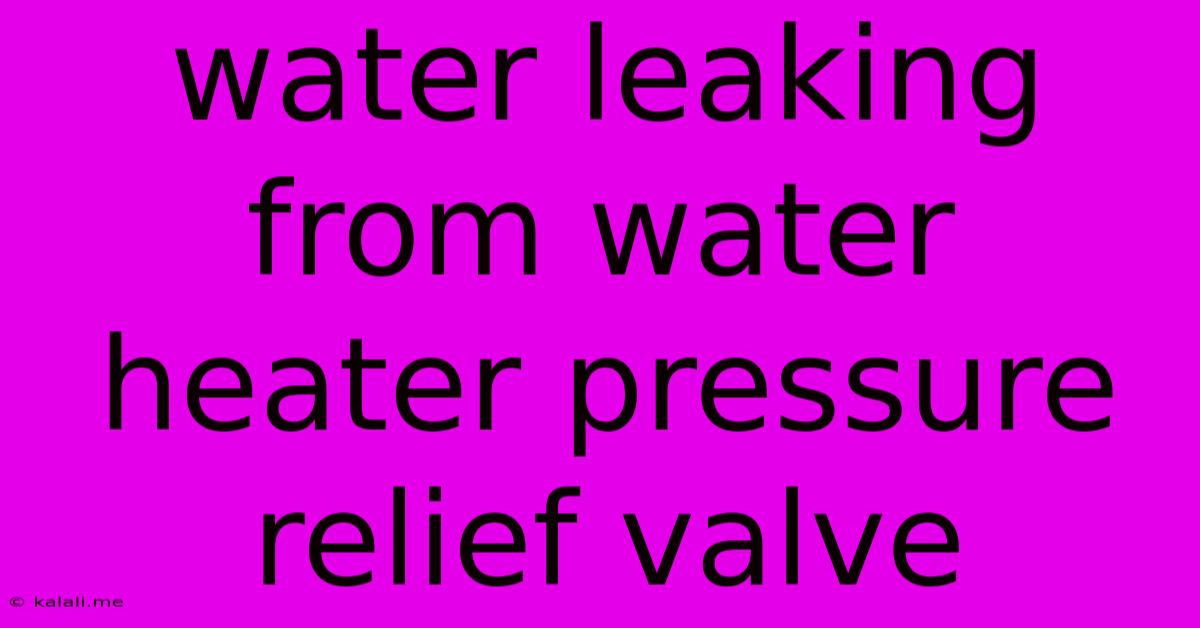Water Leaking From Water Heater Pressure Relief Valve
Kalali
Jun 04, 2025 · 4 min read

Table of Contents
Water Leaking from Water Heater Pressure Relief Valve: Causes and Solutions
Meta Description: Experiencing water leaking from your water heater's pressure relief valve? This comprehensive guide explores common causes, from excessive pressure to a faulty valve, offering effective troubleshooting and repair solutions. Learn how to identify the problem and prevent future leaks.
A leaking water heater pressure relief valve is a serious issue that demands immediate attention. This seemingly small leak can quickly escalate into significant water damage, potentially leading to costly repairs and even health hazards from mold and mildew. Understanding the underlying causes is crucial for effective troubleshooting and preventing future problems. This guide will walk you through the most common reasons for a leaking pressure relief valve and provide solutions to address them.
Understanding the Pressure Relief Valve
Before diving into troubleshooting, it's essential to understand the function of the pressure relief valve (PRV). This safety device is designed to release excess pressure within the water heater tank. Excessive pressure can build up due to various factors, including overheating, sediment buildup, or a malfunctioning temperature and pressure relief valve (T&P valve). The PRV acts as a crucial safety mechanism, preventing potentially dangerous tank ruptures. When the pressure inside the tank exceeds a predetermined limit (typically around 150 PSI), the valve automatically opens, releasing hot water to alleviate the pressure. A small drip from the PRV is sometimes normal after the valve has operated, but a constant stream of water indicates a problem.
Common Causes of a Leaking Pressure Relief Valve
Several factors can contribute to a constantly leaking water heater pressure relief valve. These include:
- Excessive Water Pressure: High water pressure in your home's plumbing system is a frequent culprit. The PRV may constantly release water to relieve the pressure that's exceeding its threshold. Check your home's water pressure using a pressure gauge. If it's excessively high (above 80 PSI), consider installing a pressure regulator to reduce it.
- Faulty Temperature and Pressure Relief Valve: The valve itself might be malfunctioning. Over time, the valve's internal components can wear out, become corroded, or simply fail, leading to a constant leak. Replacing the T&P valve is usually the solution in this case.
- Sediment Buildup: Mineral deposits and sediment accumulating at the bottom of the water heater tank can restrict water flow. This can cause increased pressure and trigger the PRV to leak. Regular flushing of the tank can help prevent this.
- Overheating: A malfunctioning thermostat or heating element can cause the water in the tank to overheat, increasing pressure and activating the PRV. Inspect and test these components as needed.
- Blocked Vent Pipe: If the vent pipe for the water heater is clogged, it can hinder pressure equalization, leading to a pressure build-up and a leaking PRV. Check the vent pipe for any obstructions.
Troubleshooting and Repair
Addressing a leaking pressure relief valve often requires a combination of diagnostic steps and potential repairs. The following steps can assist in pinpointing the problem and determining the best course of action:
- Check Water Pressure: As mentioned earlier, excessive water pressure is a common cause. Use a pressure gauge to check your home's water pressure and install a pressure regulator if necessary.
- Inspect the PRV: Carefully examine the valve for any visible signs of damage, corrosion, or mineral deposits.
- Flush the Water Heater: Regularly flushing the tank helps remove sediment buildup, reducing pressure and potentially resolving the leak. Consult your water heater's manual for proper flushing procedures.
- Replace the T&P Valve: If the inspection reveals damage or the leak persists despite other troubleshooting, replacing the T&P valve is often the most effective solution. This is a relatively straightforward DIY project for those comfortable with basic plumbing, however, consult a professional plumber if you are unsure.
- Check Thermostat and Heating Element: Inspect these components for proper functionality to rule out overheating as the cause.
Preventing Future Leaks
Regular maintenance can significantly reduce the risk of future leaks. Consider these preventive measures:
- Annual Inspection: Schedule an annual inspection of your water heater by a qualified technician.
- Regular Flushing: Flush your water heater every six months to a year to remove sediment buildup.
- Monitor Water Pressure: Regularly check your home's water pressure to ensure it remains within the recommended range.
A leaking pressure relief valve isn't something to ignore. By understanding the potential causes and taking appropriate action, you can address the problem effectively and prevent more serious damage. Remember, if you're uncomfortable performing any plumbing repairs yourself, it's always best to consult a licensed plumber. They possess the expertise and tools to diagnose and fix the issue safely and efficiently.
Latest Posts
Latest Posts
-
Stardew Does Tiller Work In Multiplayer
Jun 06, 2025
-
I Would Be Please To Chat With You Or
Jun 06, 2025
-
Is It Safe To Make Soucemap Available In Production
Jun 06, 2025
-
Christ In Us The Hope Of Glory
Jun 06, 2025
-
S Corp Capital Gain Vs Personal Capital Gain
Jun 06, 2025
Related Post
Thank you for visiting our website which covers about Water Leaking From Water Heater Pressure Relief Valve . We hope the information provided has been useful to you. Feel free to contact us if you have any questions or need further assistance. See you next time and don't miss to bookmark.